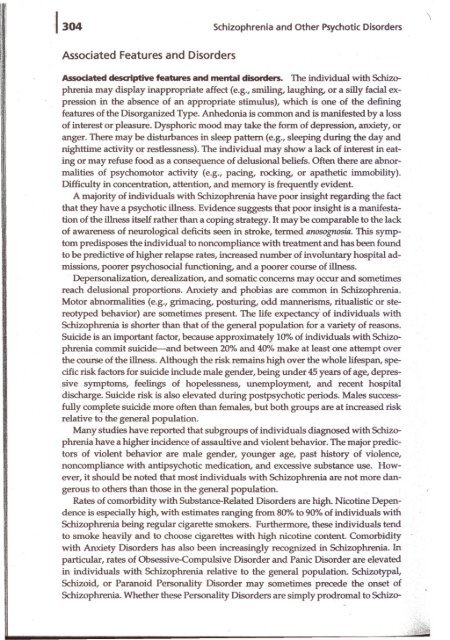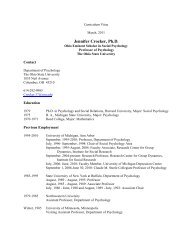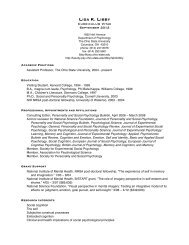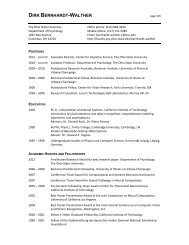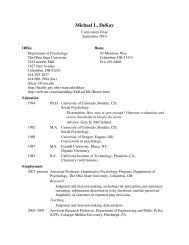Schizophrenia and Other Psychotic Disorders pg297-315.pdf
Schizophrenia and Other Psychotic Disorders pg297-315.pdf
Schizophrenia and Other Psychotic Disorders pg297-315.pdf
You also want an ePaper? Increase the reach of your titles
YUMPU automatically turns print PDFs into web optimized ePapers that Google loves.
1304 <strong>Schizophrenia</strong> <strong>and</strong> <strong>Other</strong> <strong>Psychotic</strong> <strong>Disorders</strong><br />
Associated Features <strong>and</strong> <strong>Disorders</strong><br />
Associated desaiptive features <strong>and</strong> mental disorders. The individual with Schiz0<br />
phrenia may display inappropriate affect (e.g., smiling, laughing, or a silly facial expression<br />
in the absence of an appropriate stimulus), which is one of the definIDg<br />
features of the Disorganized Type. Anhedonia is common <strong>and</strong> is manifested by a loss<br />
of interest or pleasure. Dysphoric mood may take the form of depression, anxiety, or<br />
anger. There may be disturbances in sleep pattern (e.g., sleeping during the day <strong>and</strong><br />
nighttime activity or restlessness). The individual may show a lack of interest in eating<br />
or may refuse food as a consequence of delusional beliefs. Often there are abnormalities<br />
of psychomotor activity (e.g., pacing, rocking, or apathetic immobility).<br />
Difficulty in concentration, attention, <strong>and</strong> memory is frequently evident.<br />
A majority of individuals with <strong>Schizophrenia</strong> have poor insight regarding the fact<br />
that they have a psychotic illness. Evidence suggests that poor insight is a manifestation<br />
of the illness itself rather than a coping strategy. It may be comparable to the lack<br />
of awareness of neurological deficits seen in stroke, termed anosognosia. This symptom<br />
predisposes the individual to noncompliance with treatment <strong>and</strong> has been found<br />
to be predictive of higher relapse rates, increased number of involuntarY hospital admissions,<br />
poorer psychosocial functioning, <strong>and</strong> a poorer course of illness.<br />
Depersonalization, derealization, <strong>and</strong> somatic concerns may occur <strong>and</strong> sometimes<br />
reach delusional proportions. Anxiety <strong>and</strong> phobias are common ii1 <strong>Schizophrenia</strong>.<br />
Motor abnormalities (e.g., grimacing, posturing, odd mannerisms, ritualistic or stereotyped<br />
behavior) are sometimes present. The life expectancy' of individuals with<br />
<strong>Schizophrenia</strong> is shorter than that of the general population for a variety of reasons.<br />
Suicide is an important factor, because approximately 10"10 of individuals with Schiz0phrenia<br />
commit suicide-<strong>and</strong> between 20% <strong>and</strong> 40% make at least one attempt over<br />
the courSe of the illness. Although the risk remains high over the whole lifespan, specific<br />
risk factors for suicide include male gehder, being under 45 years of age, depressive<br />
symptoms, 'feelings of hopelessness, unemployment, <strong>and</strong> ~t hospital.<br />
discharge. Suicide risk is also elevated during postpsychotic periods. Males successfully<br />
complete suicide more often than females, but both groups are at increased risk<br />
relative to the general population ..<br />
Many studies have reported that subgroups of individuals diagnosed with Schiz0phrenia<br />
have a higher incidence of assaultive <strong>and</strong> violent behavior. Themajorpredictors<br />
of violent behavior are male gender, younger age, past history of violence,<br />
noncompliance with antipsychotic medication, <strong>and</strong> excessive substance use. However,<br />
it should be noted that most individuals With <strong>Schizophrenia</strong> are not more dangerous<br />
to others than those in the general population.<br />
Rates of comorbidity with Substance-Related <strong>Disorders</strong> are high. Nicotine Dependence<br />
is especially high, with estimates ranging from 80"/0 to 90% of individuals with<br />
<strong>Schizophrenia</strong> being regular cigarette smokers. Furthermore, these individuals tend<br />
to smoke heavily <strong>and</strong> to choose cigarettes with high nicotine content. Comorbidity<br />
with Anxiety <strong>Disorders</strong> has also been increasingly recognized in <strong>Schizophrenia</strong>. In<br />
particular, rates of Obsessive-Compulsive Disorder <strong>and</strong> Panic Disorder are elevated<br />
in individuals with <strong>Schizophrenia</strong> relative to the general population. Schizotypal,<br />
Schizoid, or Paranoid Personality Disorder may sometimes precede the onset of<br />
<strong>Schizophrenia</strong>. Whether these Personality <strong>Disorders</strong> are simply prodromal to Schizo-<br />
\


